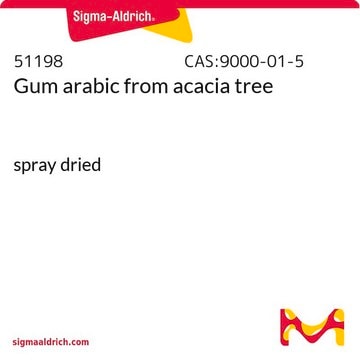Recommended Products
form
powder
color
beige
useful pH range
5.0-7.0 (25 °C, 1% in water)
Looking for similar products? Visit Product Comparison Guide
General description
Guar is extracted from the seeds of Cyamopsis tetragonoloba. It contains polysaccharides of galactomannans. Guar is used in thickening dye solution, production of paper and as a primary gelling agent in water-based slurry explosives. It acts as a fiber deflocculent and dry-strength additive and serves as an additive to dynamite for water blocking. Guar is used as a stabilizer, emulsifier and thickener in food products. It lowers cholesterol and glucose level. Guar aids weight loss and obesity prevention.
Application
Guar has been used:
- to maintain viscosity during in vitro starch digestion assay
- to reduce the thinning rate of agarose gel
- to study its effects on establishing 3D-like neural networks on microelectrode arrays (MEAs)
Biochem/physiol Actions
Guar gum has been shown to have numerous beneficial effects including improved glucose tolerance and attenuation of diabetic nephropathy.
Other Notes
Guar gum is isolated from the endosperm of the guar or gavar bean.
To gain a comprehensive understanding of our extensive range of Polysaccharides for your research, we encourage you to visit our Carbohydrates Category page.
Storage Class Code
11 - Combustible Solids
WGK
WGK 1
Flash Point(F)
Not applicable
Flash Point(C)
Not applicable
Personal Protective Equipment
dust mask type N95 (US), Eyeshields, Gloves
Certificates of Analysis (COA)
Search for Certificates of Analysis (COA) by entering the products Lot/Batch Number. Lot and Batch Numbers can be found on a product’s label following the words ‘Lot’ or ‘Batch’.
Already Own This Product?
Find documentation for the products that you have recently purchased in the Document Library.
Customers Also Viewed
In vitro starch digestion kinetics of diets varying in resistant starch and arabinoxylan compared with in vivo portal appearance of glucose in pigs
Vangsoe CT, et al.
Food Research International, 88, 199-206 (2016)
Chiranjib Banerjee et al.
Carbohydrate polymers, 92(1), 675-681 (2012-12-12)
Microalgae are small in size with negatively charged surface. They are usually stable in suspension culture and hard to flocculate. The present work emphasizes on the synthesis of cationic guar gum (CGG) by the introduction of quaternary amine groups onto
Bosi Mao et al.
Scientific reports, 7, 41185-41185 (2017-01-24)
Agarose gels are viscoelastic soft solids that display a porous microstructure filled with water at 90% w/w or more. Despite an extensive use in food industry and microbiology, little is known about the drying kinetics of such squishy solids, which
Anne J Wanders et al.
The British journal of nutrition, 109(7), 1330-1337 (2012-08-02)
The objective was to determine the effects of dietary fibre with bulking, viscous and gel-forming properties on satiation, and to identify the underlying mechanisms. We conducted a randomised crossover study with 121 men and women. Subjects were healthy, non-restrained eaters
Masood Sadiq Butt et al.
Critical reviews in food science and nutrition, 47(4), 389-396 (2007-04-26)
The number of hypercholesterolemic and hyperglycemic people is increasing rapidly in the world. The prevention against these health problems is related to a complex management of conventional and non-conventional risk factors. The inclusion of dietary fiber in the diet is
Our team of scientists has experience in all areas of research including Life Science, Material Science, Chemical Synthesis, Chromatography, Analytical and many others.
Contact Technical Service








